When Tim and Christine Ruggiero bought their dream home on 10 acres in Decatur six years ago, they imagined their daughter riding horses and taking in the clean country air. The last thing they imagined was that all three of them would end up covered in rashes from being exposed to toxic chemicals such as benzene and arsenic in their own backyard.
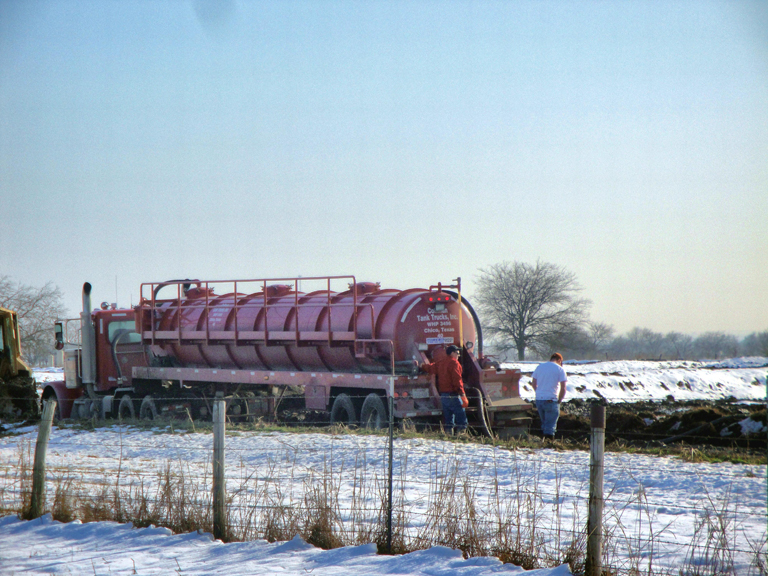 The family doesn’t own the mineral rights on their property, and earlier this year, they had no say in the matter when Aruba Petroleum showed up to drill a gas well 300 yards away from their door. The Ruggieros made a decision then to allow Aruba surface use of part of their land, in return for a $30,000 one-time payment. They didn’t understand then what trouble and toxins they were letting themselves in for.
The family doesn’t own the mineral rights on their property, and earlier this year, they had no say in the matter when Aruba Petroleum showed up to drill a gas well 300 yards away from their door. The Ruggieros made a decision then to allow Aruba surface use of part of their land, in return for a $30,000 one-time payment. They didn’t understand then what trouble and toxins they were letting themselves in for.
The drilling caused its own problems, but it wasn’t until the company spread muddy drilling waste over several acres of their land that all three of the Ruggieros, at about the same time, began to suffer from similar-looking rashes.
“We get it in different places on our body,” said Tim Ruggiero. “If you look at it, it all looks like the same rash. One of our neighbors has the same rash, and she has it worse than we do.”
Alisa Rich, president and co-founder of Wolf Eagle Environmental Engineers and Consultants, said that several of her clients have experienced similar rashes that appear as fast as 15 minutes after they are exposed to toxic wastes from gas drilling operations.
“We believe it is from some of the chemicals, specifically some of the sulfites,” she said. The extent of the rash, she said, seems to depend on the concentration of the chemicals.
In the Ruggieros’ case, the foul-smelling mud that drilling crews had spread over their land turned out, when tested by Rich’s company, to contain high levels of arsenic and benzene, both of which can cause cancer.
It’s a situation that is happening more and more often in Texas, as the Barnett Shale boom continues. Drilling produces major quantities of sludgy waste — and many activists, scientists, and landowners are very worried about where that waste is going, what’s in it, and how the dumping of that chemical-laden mud is being regulated.
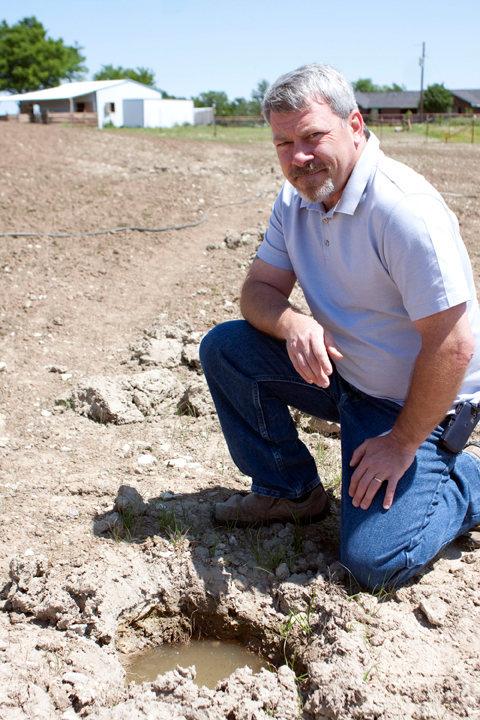 The practice is called land farming, and it’s legal in Texas and lots of other places, though there are restrictions on where and how much of the drilling waste may be spread and how full of toxins it is allowed to be.
The practice is called land farming, and it’s legal in Texas and lots of other places, though there are restrictions on where and how much of the drilling waste may be spread and how full of toxins it is allowed to be.
Oil and gas officials say that the process is safe and actually helps the land — that the drilling waste acts as fertilizer and makes grass and other crops grow more lush and green than before.
Ramona Nye, a spokeswoman for the Texas Railroad Commission, which is charged with regulating the oil and gas industry, said that land farms pose no real threat.
Many scientists also say that, if done properly and in small doses, land farming may actually be a viable and safe way to dispose of drilling mud. However, opponents of the practice have documented numerous cases of oil and gas companies cutting corners and risking the safety of the people and animals who live near the land farms and waste pits.
Many rural families fear that anything grown on acreage that has been improperly land farmed may be contaminated with carcinogens and that the grass and crops are potentially harmful to humans and animals. In some cases, they report, animals will not even eat the affected grass.
Both activists and scientists say that the land itself isn’t the only thing being threatened by land farming. When the mud dries up, if it has not been properly tilled into the soil, a stiff wind can pick up toxins and blow them around the landscape, affecting neighbors and, eventually, the air quality of a whole region. And in wet weather, they believe, toxins from the mud can run off into creeks and contaminate surrounding water supplies.
That’s what happened in Arkansas, which last year began the process of revoking permits on 11 land-farm sites where runoff had contaminated local water supplies.
In Texas, critics of the Railroad Commission point out that, in an area with more than 15,000 shale gas wells, there is only one state-permitted commercial land farm. But more than 6,500 permits for small, temporary — and much less regulated — land farms have been issued since 2005.
Activists believe that much of the waste mud from drilling is being dumped illegally, without consent of surface owners or under illegal conditions. They also charge that the oil and gas industry is largely allowed to police itself on waste-disposal practices. It is the drillers themselves who test the waste to see whether it is too toxic to dump. And when citizens go looking for those records, to see for themselves what is being dumped on their land or their neighbors’ or what is running off into their creeks or blowing across their yards, they find that the records are almost impossible to obtain. The companies are also supposed to test land-farm and waste-pit sites daily. The only oversight the Railroad Commission performs, according to Nye, is reporting requirements and routine, unannounced inspections.
Well-known blogger and activist Sharon Wilson, who lives close to several land farms in Decatur, is one of many who believe that the current regulatory system is not just broken but nonexistent.
“It’s an honor system,” she said. “If they [oil and gas companies] find out that [the mud] is too toxic to land farm it, then what do they do? They have to pay more money to dispose of it. Do you think they ever find any that’s too toxic?”
Dick Ross, who lives 50 feet away from a 100-acre land farm and just down the road from another, said that he is ready to sell his house and move somewhere far away. He has been a one-man protest rally against land farming and has been engaged in what he characterized as a pitched battle with the Railroad Commission, which, he said, exists only to serve oil and gas companies, not to regulate them.
“The Railroad Commission is in the pockets of oil and gas companies,” he said. “They make all of these rules and regulations, and they never back them up.”
Several other states, Wilson said, have toughened their laws and their oversight of land-farming practices.
“Texas can’t seem to learn by watching others,” she said. “We just keep on letting the industry have complete carte blanche.”
Shale gas wells have produced many millions of dollars for gas companies, governments, and, in some cases, landowners in Texas. But the process is also highly productive of something else: waste. The millions of gallons of toxic wastewater produced by drilling operations are disposed of underground in injection wells meant to isolate the chemical-laden and super-salty liquids. But the process also produces a mountain of slushy waste that must go somewhere. It includes drilling “mud” — the clay, water, and chemical slurry that’s used to keep drilling bits lubricated and bring drilled-out material to the surface. But mixed in with it are those drilled-out materials, which can be radioactive, and many other chemicals.
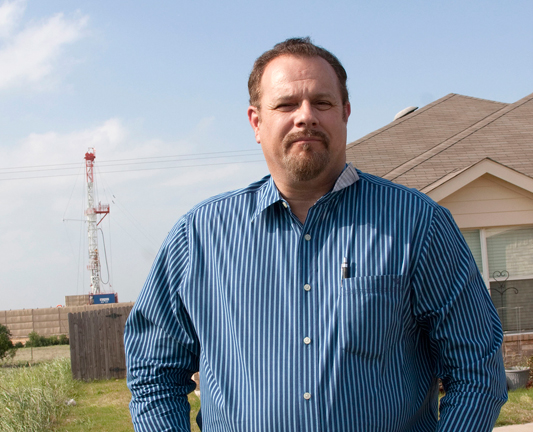 In most cases, the sludge is first put into a waste pit at the well site, so that some of the liquid can evaporate. In Texas, there is no requirement for those pits to be either lined or fenced, meaning that chemicals can leach into the ground and that farm animals and wildlife have access to them.
In most cases, the sludge is first put into a waste pit at the well site, so that some of the liquid can evaporate. In Texas, there is no requirement for those pits to be either lined or fenced, meaning that chemicals can leach into the ground and that farm animals and wildlife have access to them.
Companies then take the slightly drier sludge and spread it out over a large piece of ground, like poisonous jam on toast. The waste is tilled into the soil so that, theoretically, microbes from the healthy soil can eat dangerous hydrocarbons, enriching the soil in the process. The companies then scrape the stuff up again and take it to a permanent land-farm disposal site.
That last step was what began happening two years ago on the Hill County ranch next to Dick Ross’ place, but he didn’t understand it then.
The first he knew of it was when a seemingly endless procession of 18-wheelers began rolling in and out of his neighbor’s property in the pre-dawn hours. Ross, a 62-year-old retiree, started calling around. He had no idea that he was entering a rabbit hole that would consume the next two years of his life.
Upset with the noise of the trucks and worried about toxic dust blowing onto his property, Ross raised a ruckus. In the ensuing months, he became one of the most prominent land-farming activists and experts in North Texas.
“They are dumping millions of gallons of hazardous waste here,” he told Fort Worth Weekly in an angry, exasperated tone. “They are polluting water wells, destroying land, jeopardizing my family’s health. I have the same problem that the people in DISH have, except it’s not just the air. I have contacted all my local, state, and federal representatives, and not one of them will do anything to help. They are all financed by the energy industry.”
Ross had to teach himself everything he knows about land farming and how the oil and gas business works. Because he is poor, he said, he cannot afford to hire a lawyer to fight the land farms in court and cannot afford the same kind of independent tests that the Ruggiero family had done.
He takes credit for a major change in drilling-related laws in recent years: the addition of a requirement that land- farming sites be at least half a mile apart. Though he never requested the change, he believes that the industry was forced to make it because of his complaints and persistence.
Ross said his biggest frustration is that there is no one policing energy companies. He believes they operate freely, often outside of the law.
There are three types of land-farm permits issued by the Railroad Commission. “Minor” permits, for up to 60 days, involve smaller volumes of drilling mud. “Centralized” permits last between two and five years and involve larger volumes of waste. Then there are commercial land farms. All land-farm permits, according to Nye, require the approval of the surface owner. Minor permits can be issued by the commission’s district offices, and the larger permits are issued out of Austin.
Ross and others say that oil and gas companies get around using the commercial land farm by abusing the law on smaller land farms. For example, the land farm across from Ross is on a minor permit for three acres, though the property is close to 100 acres. What the Railroad Commission did, Ross said, was to issue 22 minor permits for 22 allegedly separate operations on the property.
Ross has made countless complaints about this to the commission, to no avail. He said that obtaining multiple “minor” permits for what is actually a major commercial dumping operation is standard procedure in the industry.
Nye did not respond to questions about the propriety of the commission’s issuing multiple permits in such situations.
Operators of land farms that accept waste from multiple drilling sites or multiple companies are required to obtain a centralized land-farm permit. Such sites are more closely regulated than “minor” operations, though the state still does not require the waste pits there to be lined in all cases. Ross points out that there has been only one centralized permit issued in the Barnett Shale — and that was issued to TXO for a site on private property three miles from Ross’ home.
“Why would somebody drive all the way from Tarrant County in an 18-wheeler, drive 60 to 70 miles to drop a tank of [waste mud] in Hill County?” he said. “Surely they can find somewhere closer.”
According to records obtained by the Weekly, XTO is allowing other energy companies to dump their waste on that land. The owner of the land, Ross said, has made millions of dollars by allowing the companies to use his property as a toxic dumping ground. The property is also dangerously close to the area’s well-water supply, he said.
By law, land-farm operators are not allowed to contaminate surface or subsurface water. “An operator must consider this prohibition when constructing a [waste] pit,” Nye wrote in an e-mail.
She denied that land farming and waste pits are unregulated. However, in almost every reply she provided to the Weekly, she noted that the operators of the land farms are responsible for testing.
For example, oil and gas companies are responsible for not allowing runoff to leak into nearby creeks or soil. “It is the operator’s responsibility to monitor and maintain a pit to prevent any unauthorized discharge to the surrounding area,” Nye said.
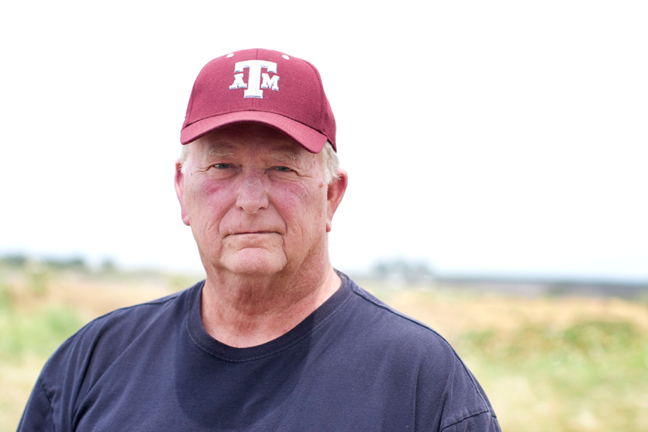 She said that the Railroad Commission has “referred land-farm permits to enforcement” for multiple violations but also noted that, “To this date, all corrective actions required by Barnett Shale local district offices have been achieved without having to resort to filing enforcement actions, according to staff.”
She said that the Railroad Commission has “referred land-farm permits to enforcement” for multiple violations but also noted that, “To this date, all corrective actions required by Barnett Shale local district offices have been achieved without having to resort to filing enforcement actions, according to staff.”
Nye also said that operators of some small disposal sites are not required to do sampling or analysis of the material accepted for disposal. In larger pits and land farms, she said, it is the responsibility of the operator to sample and analyze pit contents.
“The Commission may require an operator to test soil in the case of a complaint, spill, discharge from the permitted area, or some other circumstance that may arise,” she said.
When the land-farm sites have reached capacity and are to be closed, state law requires a soil analysis. According to records obtained by Ross, the Railroad Commission district that covers the Barnett Shale area has never asked for any such analyses.
Gary Hogan, a Fort Worth environmentalist and drilling activist, forced drillers to remove sludge they had spread on property behind his home, back in 2005.
“In the early days of the gas drilling, I had an open drilling pit on the first well that they drilled” on the site, he said. “They weren’t supposed to have an open, unlined pit, but who knew at that time?
“When they got done drilling, they took all of the mud out of that pit, and they spread it on this 13 or so acres of land on a field behind my house. I had a concern, so I called the gas well inspector’s office at that time, and the next thing I knew, they were scooping that stuff up and putting it in trucks and hauling it all off.”
There are very few, if any, other documented examples of land farms in Tarrant County. Ross believes that is by design.
“They are not doing this in Tarrant,” Ross said. “They’re doing this in the country because there’s no one around to police them.”
Last September, Tim Ruggiero was at work when his neighbor called to say that a crew was digging up his property. He and his wife rushed home to find a backhoe at work in his horse pasture, about 300 feet away from his front door. Now parts of the property look like a scene from a post-apocalyptic movie: Remnants of a muddy mound teeming with dangerous chemicals partially fills a waste pit within a football field’s reach of the house, and there are holes in the ground filled with a red liquid that ignites when lighted by a match, caused by what the Ruggieros believe is a methane leak.
Ruggiero said that when he confronted the drilling crew, the foreman told him they could drill without the couple’s permission, and, what’s more, they could use the surface of the land as well, whether he agreed or not. (Drillers can claim use of some surface land during drilling, but rights to spread drilling waste on the land are not automatically included.)
“He said [Aruba] was trying to be a good neighbor” by offering to pay the family $30,000 for those surface rights when it didn’t have to, Ruggiero said.
Not knowing the ins and outs of the situation, the couple agreed to take the check.
Since then, they have struggled repeatedly to limit the intrusions of the drillers and to make them adhere to whatever rules apply, both to the drilling operation itself and to use of their land for spreading waste. The Ruggieros say they’ve gotten almost no help from the Railroad Commission in trying to protect their health, home, and property.
After months of drilling, Ruggiero said, the crews put all of the toxic mud into a waste pit, where it sat for a number of months. Then the workers mixed what one truck driver described as cement kiln dust into the muddy mix to soak up some of the chemical soup.
“They let that sit for about a week and used a backhoe to scoop it all out and a bulldozer to spread it out all over the place,” said Ruggiero. “That sat there for I don’t know how many weeks. Then a bulldozer came back and pushed it all back into the pit.”
Nye said that the Ruggiero property was not land farmed but was the site of a drilling reserve pit. However, the Ruggieros provided the Weekly with photo evidence to the contrary. Nye also said that the analysis of chemicals provided to the commission by Wolf Eagle did not show any arsenic.
“Three soil samples taken by Wolf and provided to the commission recorded results for benzene below regulatory limits, she said. “And, since Jan. 11, when these samples were collected, the operator has cleaned up the pit site.”
Ruggiero said that the smell was so bad he called the Texas Commission on Environmental Quality to inspect it.
“There was a very strong sewage smell, a hydrocarbon odor to it, and some other acrid chemical smell,” he said.
The smell worried them so much that they hired Rich’s company to test the soil and water. The testing company found more than a dozen dangerous chemicals, including high levels of several carcinogens.
Rich said that the heavy rains during the past winter made land farming in this area even more dangerous.
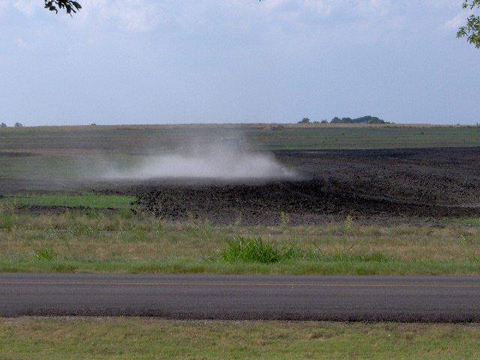 “We’ve had a very wet winter, and what had happened on a lot of properties, not just the Ruggerios’, is that much of the hydrocarbons that were intended to be land farmed got rinsed off into the streams, rivers, and creeks in the area and got washed off onto the property,” she said.
“We’ve had a very wet winter, and what had happened on a lot of properties, not just the Ruggerios’, is that much of the hydrocarbons that were intended to be land farmed got rinsed off into the streams, rivers, and creeks in the area and got washed off onto the property,” she said.
The Ruggerios are on well water, so the rain that fell on their land farm posed a particularly big threat. The well water, according to the Wolf Eagle Test, was indeed contaminated and unsafe.
“Who knows how much of that seeps farther into the ground and alternately into the water table?” Ruggerio said.
Rich said that she has encountered several examples of the chemicals from land farms running off into creeks.
“I have definitely seen it in Wise County. I have seen a land farm next to a creek that feeds the Trinity River,” she said. “Land farming was occurring on large acreage, and due to heavy rains, the creek water was [affected].”
She also said that she herself has witnessed the illegal dumping of drilling mud into creeks.
“I literally saw a guy at Mountain Creek unloading his drill mud into the creek while they were drilling a new well,” she said. “When he saw me, he stopped and waited until I drove off.
“I have another client where drilling mud was, without any question, deposited into their stream. And they didn’t find out about it for three months because of the size of the property.”
Rich also said that soil that has been land farmed could be dangerous for growing food, and the grass could be a threat to grazing animals. She cited an example of farmers who grew peanuts on contaminated soil. Growing peanuts actually helps to re-enrich depleted soil, so it’s not an uncommon practice, but in this case people who ate those peanuts suffered anaphylactic shock.
“I would not want to eat those [crops],” she said.
Sam Feagley, a soil and crops sciences professor at Texas A&M University, said that he has never encountered an example of crops or animals that were contaminated by the residual effects of land farming.
“From what we’ve seen and what I’ve found, if it’s done properly, you won’t have any problems,” he said. “The only problem that I’ve ever seen with drilling mud is if it gets put on too thick, you may actually kill the forage and have to start [the re-enrichment] process over again.”
Rich, however, cited an example of a client who had recently lost two calves because they drank out of a creek that was contaminated by the same drilling fluids that mix with the waste mud.
“On a lot of these large acreages, you have gas wells with the animals right next to them, so what if they are eating chemicals their whole life?,’” she said. “I can tell you that I’ve seen some amazingly green grass that the cows won’t eat. So my guess is there’s a chemical taste to it, as our food would be bitter if we grew something in poor quality soil.”
Ross said that his neighbor across the street, who leased his property to an oil and gas company for land farming, found that, after the lease was up, he couldn’t get anything to grow there. After several barren seasons and many failed attempts, he has managed to grow wheat, but there are still dead patches where nothing will grow, Ross said.
The Ruggerios said they felt pressured to make a split-second decision.
“They offered that to us hours after they already cut down our pipe and fence and started bulldozing the land without prior notice. My wife and I are often criticized for taking the money, and my response has always been, ‘If you were in my shoes, what would you do?’ ”
There is an element of sweet revenge to leaven the bitterness of that part of the story, however.
“We’ve used over 10,000 of those dollars to pay for attorney fees and testing the soil, the air, and the water,” he said.











